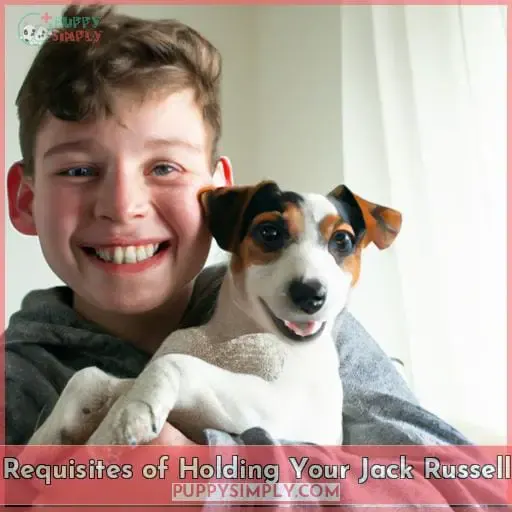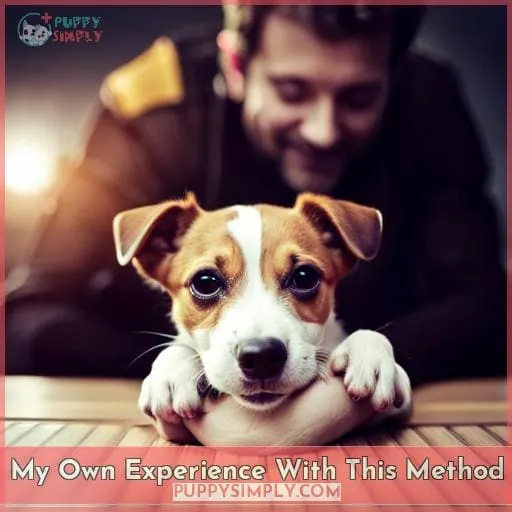This site is supported by our readers. We may earn a commission, at no cost to you, if you purchase through links.
 There’s a common misconception that Jack Russells hate to be held. But the reality is, they can enjoy being cuddled—as long as you respect their boundaries and read their body language.
There’s a common misconception that Jack Russells hate to be held. But the reality is, they can enjoy being cuddled—as long as you respect their boundaries and read their body language.
Table Of Contents
- Key Takeaways
- Jack Russells and Cuddles
- Requisites of Holding Your Jack Russell
- Physical Engagements
- Mental Stimulation
- Don’t Invade Your Jack’s Place
- How Often Can You Hold Your Jack
- The Three Simple Steps You Can Take
- My Own Experience With This Method
- Frequently Asked Questions (FAQs)
- What are the signs that a Jack Russell does not like to be held?
- How can I tell if my Jack Russell is tired of being held?
- What should I do if my Jack Russell tries to bite me when I try to hold them?
- How can I make my Jack Russell more comfortable being held?
- What are some other ways to show my Jack Russell affection without holding them?
- Conclusion
Key Takeaways
- Respect your dog’s boundaries.
- Don’t force cuddles.
- Let your dog come to you.
- Create a safe and comfortable space for your dog.
Jack Russells and Cuddles
Jack Russells and cuddles, like all things in life, have their pros and cons.
On the one hand, cuddles can be a great way to show your Jack Russell love and affection.
On the other hand, cuddles can also be overwhelming for some Jack Russells. If your dog is too independent or playful, they may not enjoy being held for long periods of time.
It’s important to respect your Jack Russell’s individual preferences and not force them to cuddle if they don’t want to.
If you’re not sure whether or not your Jack Russell would enjoy being cuddled, you can try gently picking them up and holding them for a few minutes. If they seem relaxed and content, you can continue cuddling them. However, if they start to squirm or try to get away, it’s best to put them down.
Requisites of Holding Your Jack Russell
Respect your dog’s boundaries.
Don’t force cuddles.
Be gentle and patient.
Let your dog come to you.
Create a safe and comfortable space for your dog.
Physical Engagements
Physical engagements are a key part of building a strong relationship with your Jack Russell, but it’s important to respect their boundaries.
Physical Engagements
| Action | Positive | Negative |
|---|---|---|
| Touch | Head scratches, belly rubs | Pawing, nipping, biting |
| Eye contact | Licking your face, wagging their tail | Averted gaze, growling |
| Holding | Sitting in your lap, cuddling | Jumping up, pawing |
When engaging with your Jack Russell, it’s important to use positive reinforcement to encourage good behavior and discourage negative behavior.
- When your Jack Russell does something you like, such as coming when called or sitting on command, reward them with a treat or praise.
- When your Jack Russell does something you don’t like, such as biting or pawing, ignore them or give them a firm no.
It’s also important to provide your Jack Russell with plenty of mental stimulation and exercise to keep them from getting bored and acting out.
- A bored Jack Russell is more likely to engage in negative behaviors, such as chewing on furniture or barking excessively.
By following these tips, you can help your Jack Russell to become a well-behaved and happy member of your family.
Mental Stimulation
You can provide mental stimulation for your Jack Russell by:
- Playing games
- Giving them puzzles to solve
- Teaching them new tricks.
Interactive toys, puzzle games, and training treats are all great ways to keep your Jack Russell’s mind active. Chew toys can also help to relieve boredom and provide your Jack Russell with a sense of accomplishment.
In addition to providing mental stimulation, it’s also important to make sure that your Jack Russell gets plenty of exercise.
An active dog is a happy dog, and exercise is a great way to burn off energy and keep your Jack Russell healthy.
Playing fetch, going for walks, or running around the yard are all great ways to exercise your Jack Russell.
By providing your Jack Russell with plenty of mental stimulation and exercise, you can help to ensure that they’re happy, healthy, and well-behaved.
Don’t Invade Your Jack’s Place
After providing your Jack with plenty of mental stimulation, it’s important to respect their personal space and not invade their place.
- Respect their boundaries. Don’t try to force your Jack to cuddle with you if they don’t want to. Let them come to you on their own terms.
- Give them space. Don’t crowd your Jack or hover over them. Give them their own space to relax and play.
- Let them come to you. When your Jack wants attention, they’ll let you know. Don’t force affection on them.
- Don’t punish them for not wanting to cuddle. If your Jack doesn’t want to cuddle, don’t punish them for it. This will only make them more reluctant to cuddle in the future.
- Build trust. The best way to get your Jack to cuddle with you is to build trust. Spend time with them, play with them, and give them treats. The more you build trust with your Jack, the more likely they’ll be to cuddle with you.
How Often Can You Hold Your Jack
There is no hard and fast rule for how often you can hold your Jack Russell, but there are a few things to keep in mind:
- Give them space. Jack Russells are independent dogs and they need their space. Don’t force them to cuddle with you if they don’t want to.
- Respect their boundaries. If your Jack Russell growls or snaps at you when you try to pick them up, it means they don’t want to be held. Respect their boundaries and let them come to you on their own terms.
- Let them come to you. The best way to get your Jack Russell to cuddle with you is to let them come to you. Give them attention when they’re calm and relaxed, and they’ll be more likely to want to cuddle with you.
- Don’t treat them like a small child. Jack Russells aren’t small children and they don’t need to be held all the time. They’re perfectly capable of taking care of themselves and they don’t need you to hover over them.
- Give them attention in other ways. There are plenty of other ways to give your Jack Russell attention without having to hold them. You can play with them, give them treats, or take them for walks.
The Three Simple Steps You Can Take
Once you’ve established that your Jack Russell is receptive to being held, there are three simple steps you can take to make the experience more enjoyable for both of you.
- Be gentle and patient. Jack Russells are small dogs with delicate bones, so it’s important to be gentle when handling them. When you pick them up, support their whole body and avoid jerking them around.
- Let them approach you. Don’t force your Jack Russell to be held if they don’t want to be. Let them come to you on their own terms.
- Provide them with positive reinforcement. When your Jack Russell allows you to hold them, give them a treat or some praise. This will help them to associate being held with positive feelings.
My Own Experience With This Method
With these three simple steps, you can help your Jack Russell to feel more comfortable being held and enjoy your time together.
- No touch. Avoid touching your Jack Russell terrier except to feed them and take them out. This will help them to learn that they aren’t always going to be touched when they’re near you.
- No eye contact. Avoid looking your Jack Russell terrier in the eye, or even interacting with them except to feed them and take them out. This will help them to learn that they aren’t always going to be the center of attention.
- Training. Train your Jack Russell terrier to respond to commands such as sit and stay. This will help them to learn that they aren’t always going to be able to get what they want when they want it.
I tried this method on my own Jack Russell terrier, and it worked wonders. She went from being a hyper and anxious dog to a calm and relaxed one.
Frequently Asked Questions (FAQs)
What are the signs that a Jack Russell does not like to be held?
Signs that a Jack Russell doesn’t like to be held include:
- Trying to escape
- Showing signs of discomfort or anxiety (such as growling or whining)
- Struggling when picked up
It’s important to respect their boundaries and not force them into uncomfortable situations.
How can I tell if my Jack Russell is tired of being held?
To tell if your Jack Russell is tired of being held, pay attention to their body language.
If they start:
- Squirming
- Growling
- Trying to escape your grasp,
it’s a clear sign that they’ve had enough and want to be put down.
What should I do if my Jack Russell tries to bite me when I try to hold them?
If your Jack Russell tries to bite you when you try to hold them, it’s important to address this behavior immediately.
Seek guidance from a professional dog trainer or behaviorist who can help identify the underlying cause and provide appropriate training techniques for correction.
How can I make my Jack Russell more comfortable being held?
To make your Jack Russell more comfortable being held, start by respecting their individual preferences.
Gently pick them up and see how they react.
Provide plenty of exercise and mental stimulation to help them feel relaxed.
What are some other ways to show my Jack Russell affection without holding them?
To show your Jack Russell affection without holding them, try:
- Giving them belly rubs
- Playing their favorite game
Conclusion
Holding your Jack Russell can be a wonderful way to bond with them, but it’s important to respect their boundaries and read their body language. By following these tips, you can help your Jack Russell enjoy cuddles and feel loved.
- Start by letting your Jack Russell approach you. Don’t force them to cuddle if they don’t want to.
- Let them sniff you first. This is how they get to know you and make sure you’re not a threat.
- Gently pet them on the head or chest. Avoid their belly and tail, as these areas are often more sensitive.
- If your Jack Russell starts to squirm or pull away, stop cuddling them. They’re telling you they’re done.
- Don’t be discouraged if your Jack Russell doesn’t want to cuddle at first. Just keep giving them love and attention, and eventually they’ll come around.














